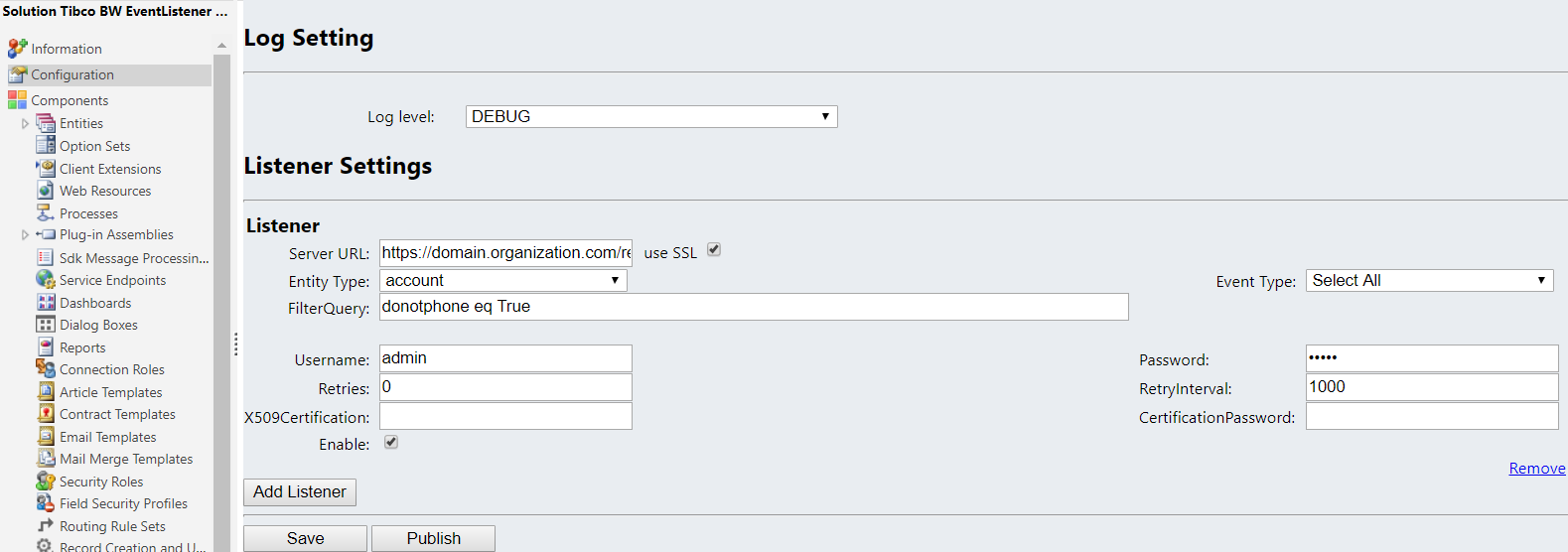Configurations for Dynamics CRM Solution
The Configuration page contains the settings for logs and listener.
| Field | Description |
|---|---|
| Log level | Specify the log level to trace different messages. See
Log Levels for more details.
Note: The
TRACE log level is not supported for Dynamics CRM solution.
|
| Listener Settings/Listener | |
| Server URL | Specify the endpoint URL for the HTTP Connection. The format is
domain_name:port_number/relative_path.Note:
|
| use SSL | Select this check box if you want to use SSL authentication to secure the message exchange of the user event triggered on a specified entry. |
| Entity type |
Select an entity from the list of entities on this Microsoft Dynamics CRM instance for which a listener is to be configured. |
| Event type |
Select the type of event, such as Select All, Create, Update, or Delete for which the listener is to be configured. |
| FilterQuery | Specify a query to filter and receive specific information for an entity event. You can create a filter query using the entity attributes so that the listener is triggered only if the filter query is satisfied. See the
tables that follow for the data types and operators supported in a filter query.
Note: Use
EMPTY to check for null or empty values in any entity or event attribute.
Example: EmpId neq EMPTY |
| Username | Specify the user name to perform basic authentication for the Entity Event Source activity.
Note: The user name that is specified here must be the value that was specified in the
Username field of Entity Event Source or REST Entity Event Source activity.
|
| Password | Specify the password to perform basic authentication for the Entity Event Source activity.
Note: The password that is specified here must be the value that was specified in the
Password field of Entity Event Source or REST Entity Event Source activity.
|
| Retries | Specify the amount of times for the Dynamics CRM solution attempting to resend user event messages to the Entity Event Source activity if the previous sending failed. |
| RetryInterval | Specify the interval period in milliseconds before the Dynamics CRM solution attempts to resend the user event messages. |
| X509Certification |
Specify the name or ID of the certification file uploaded on the Web Resources page. See Configuring SSL Client Authentication for more details. Note:
|
| CertificationPassword |
CertificationPassword is not applicable because two way SSL authentication is not supported in TIBCO Cloud Integration. Note:
|
| Enable | Specify whether the listener configuration is enabled. |
Data Types and Operators Supported in a Filter Query
The following data types and relational operators are supported in a filter query.
| Data Type | Operators | Example |
|---|---|---|
| string |
| EmpName startswith Tom |
| boolean |
| donotpostalmail eq True |
| integer/floating point/decimal |
| EmpId>=10001 |
| date time |
| DateOfJoining eq 01/01/2019 |
| optionset |
| familystatuscode eq 1 Note: You must use the optionset value, not the optionset label, in the query. In the example,
1 is the value for option "Single".
|
| Multi select Optionset |
| new_multiselectoption neq EMPTY |
| currency |
| creditlimit > 70
Note: You must not use currency symbols such as, $,₹,£, and the like in the query.
|
| lookup |
| accountid eq 00000000-0000-0000-0000-000000000000
Note: You must use the
Id field of lookup type attribute in the query.
|
The following logical operators are supported in a filter query.
| Operators | Example |
|---|---|
| name startswith Tom AND empid>=10001 AND DateOfJoining eq 01/01/2019
name startswith Tom OR empid>=10001 OR DateOfJoining eq 01/01/2019 Note: If you use AND as your first operator in a query, then you can use only AND as the operator in the rest of the query operations. Or, if you use OR as your first operator in the query, then you can use only OR as the operator in the rest of the query operations. You cannot combine AND and OR operators in a single query.
|
